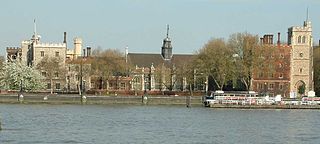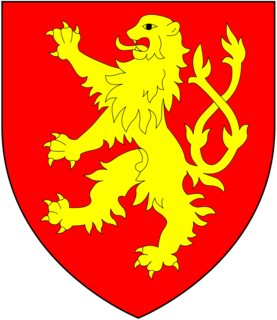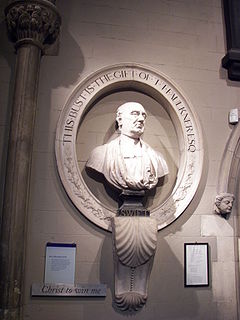Life
Derlington became a Dominican friar, and it has been inferred that he studied at Paris at the Dominican priory of St Jacques, because his name is mentioned as working on the second edition (Concordantiæ Magnæ, about 1250) of Hugues de St Cher's Latin concordance. In 1256 he was made a member of Henry III's council, and taken into the king's confidence, also at some point becoming Henry's confessor. [1]
In 1256 Derlington persuaded the king to release a converted Jew of Lincoln, imprisoned on suspicion of complicity in the murder of a child. In 1258 he helped draw up the Provisions of Oxford, as one of the king's nominees; in 1263 he was present at the drawing up of the instrument by which Henry III agreed to submit the questions arising from the provisions of Oxford to the arbitration of Louis IX. [1]
In August 1278 Derlington was part of a mission to Rome from Edward I with William of Louth and Henry of Newark. In negotiations with Pope Nicholas III, he was appointed a collector of papal revenue in England. The collection of the "tenth" was a long task, but it had hardly begun when Derlington was raised to the see of Dublin, which had been vacant since the death of Fulk Basset in 1271. The appointment was the Pope's personal choice, made to resolve a confused situation involving a bitter struggle between two rival nominees, Fromund Le Brun and William de la Corner. Edward received Derlington's homage and fealty on 27 April 1279, and next day restored him to his temporalities. He was consecrated on 26 August, at Waltham Abbey, by Archbishop John Peckham. The contentious collection of the tenth kept Derlington from his see, and the king allowed him to be represented by attorney in Ireland, and gave him special license to remain in England. [1]
Other troubles also detained Derlington, including a clash with Peckham. In 1283 Edward I seized the collected tenth for the crusade, but then was compelled to give it up. With other business over, Derlington set off for Ireland, but had not gone far from London, when he went down with a mortal sickness. He died on 28 March 1284, and was buried in the choir of Blackfriars church in London. [1]

Year 1215 (MCCXV) was a common year starting on Thursday of the Julian calendar.

Boniface of Savoy was a medieval Bishop of Belley in Savoy and Archbishop of Canterbury in England. He was the son of Thomas, Count of Savoy, and owed his initial ecclesiastical posts to his father. Other members of his family were also clergymen, and a brother succeeded his father as count. One niece was married to King Henry III of England and another was married to King Louis IX of France. It was Henry who secured Boniface's election as Archbishop, and throughout his tenure of that office he spent much time on the continent. He clashed with his bishops, with his nephew-by-marriage, and with the papacy, but managed to eliminate the archiepiscopal debt which he had inherited on taking office. During Simon de Montfort's struggle with King Henry, Boniface initially helped Montfort's cause, but later supported the king. After his death in Savoy, his tomb became the object of a cult, and he was eventually beatified in 1839.
Aymer de Valence was a Bishop of Winchester around 1250.

Bartholomew Burghersh, 1st Baron Burghersh, called "the elder", was an English nobleman and soldier, a younger son of Robert Burghersh, 1st Baron Burghersh and Maud Badlesmere, sister of Bartholomew Badlesmere, 1st Baron Badlesmere. He was the father of Bartholomew Burghersh the younger.

The House of Plantagenet was a Royal house which originated from the lands of Anjou in France. The family held the English throne from 1154 to 1485, when Richard III died in battle.

Amaury de Montfort was the third son of parliamentary pioneer Simon de Montfort, 6th Earl of Leicester, and Eleanor of England, daughter of King John.

The Dean of St Patrick's Cathedral is the senior cleric of the Protestant St Patrick's Cathedral, Dublin, elected by the chapter of the cathedral. The office was created in 1219 or 1220, by one of several charters granted to the cathedral by Archbishop Henry de Loundres between 1218 and 1220.
Fulk Basset was archbishop of Dublin. He was the elder brother of John de Sandford, who was also Archbishop of Dublin from 1284 to 1290.
John de Sandford was Archbishop of Dublin.

John Comyn II of Badenoch, nicknamed the Black Comyn, was a Scottish nobleman, a Guardian of Scotland, and one of the six Regents for Margaret, Maid of Norway. His father was John Comyn I of Badenoch.
Events from the 1270s in England.
George Browne D.D. was an English Augustinian who was appointed by Henry VIII of England to the vacant Episcopal see of Dublin. He became the king's main instrument in his desire to establish the state church in the Kingdom of Ireland. An iconoclast, during the Protestant Reformation he is noted for destroying the Bachal Isu, one of the symbols of authority of the Archbishop of Armagh.
Flann Mac Flainn was fifth Archbishop of Tuam, 1250–1256.
Richard de Abyndon, Abendon, or Abingdon was an English judge.
Alan la Zouche (1205–1270) was an English nobleman and soldier of Breton descent. He built the Zouches Manor.
Richard de Ferings, was the Archbishop of Dublin.

John D'Alton (1792–1867) was an Irish lawyer, historian, biographer and genealogist.
Luke Netterville was an Anglo-Norman churchman in Ireland, archbishop of Armagh from 1218.
Thomas de Chaddesworth or Chadsworth (c.1230-1311) was an English-born Crown servant and cleric who spent some fifty years in Ireland, and died there at a great age.
John Freind Robinson, 1st Baronet was Archdeacon of Armagh from 1786 until his resignation in 1797.
This page is based on this
Wikipedia article Text is available under the
CC BY-SA 4.0 license; additional terms may apply.
Images, videos and audio are available under their respective licenses.
![]() This article incorporates text from a publication now in the public domain : Stephen, Leslie, ed. (1888). "Darlington, John of". Dictionary of National Biography . Vol. 14. London: Smith, Elder & Co.
This article incorporates text from a publication now in the public domain : Stephen, Leslie, ed. (1888). "Darlington, John of". Dictionary of National Biography . Vol. 14. London: Smith, Elder & Co.






